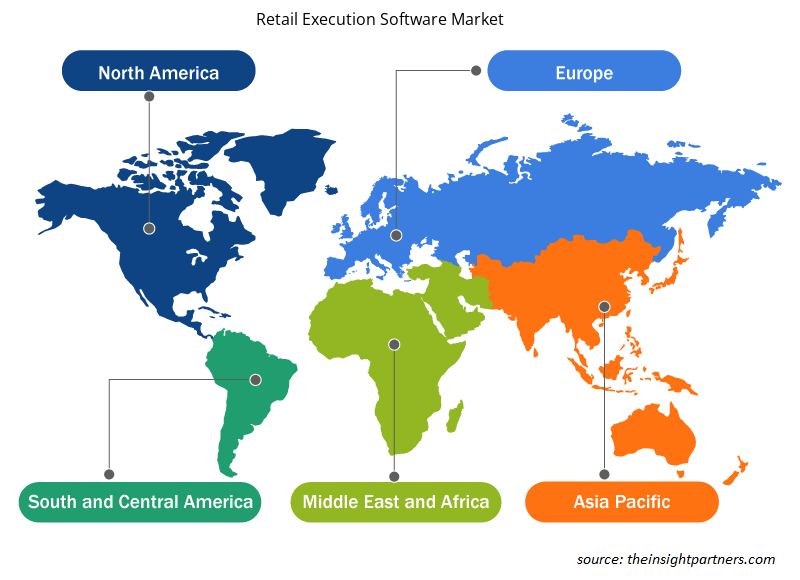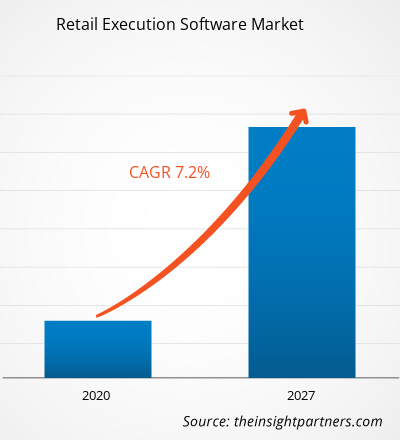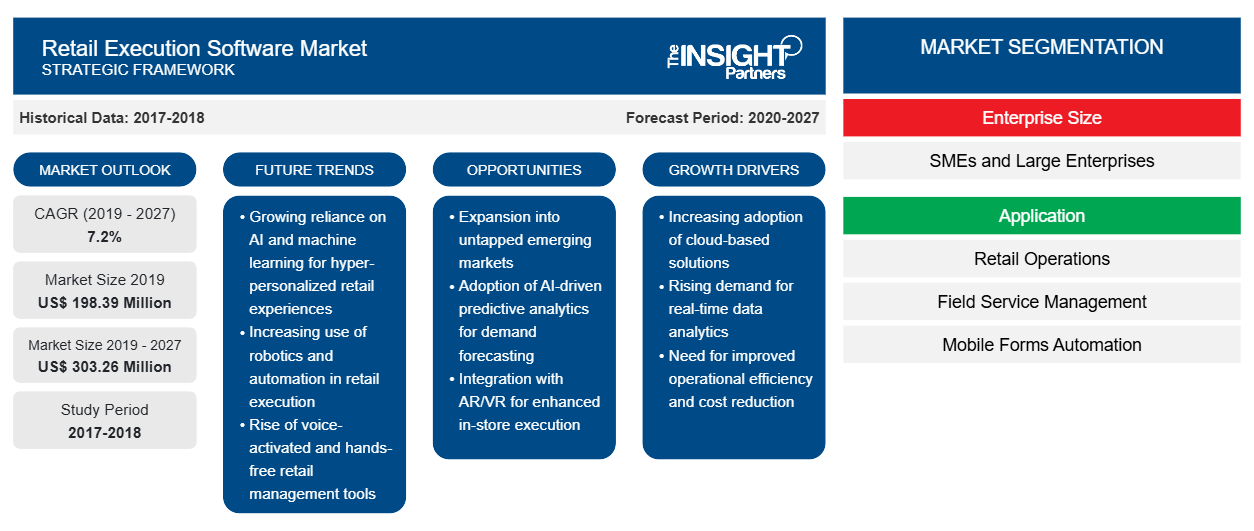소매 실행 소프트웨어 시장 규모는 2019년에 1억 9,839만 달러였으며, 2027년까지 3억 326만 달러에 도달할 것으로 예상됩니다. 2020년에서 2027년까지 연평균 성장률 7.2%로 성장할 것으로 예상됩니다.CAGR of 7.2% from 2020 to 2027.
글로벌 리테일 실행 소프트웨어 시장은 리테일 및 전자상거래 플랫폼에 대한 선호도가 높아지고 결제 게이트웨이와 리테일 실행 소프트웨어의 통합이 증가함에 따라 상당한 성장을 목격하고 있습니다. 지리적으로 북미가 31.13%의 매출 점유율로 시장을 이끌었고, 그 뒤를 유럽과 APAC가 이었습니다. 빠르게 성장하는 경제, 자동화 기술 채택 증가, 인터넷 보급률 증가, 최종 사용자의 소프트웨어 채택이 이러한 지역의 리테일 실행 소프트웨어 시장 성장을 견인할 것으로 예상되는 주요 요인 중 일부입니다. APAC 의 리테일 실행 소프트웨어 시장은 예측 기간 동안 가장 높은 CAGR로 성장할 것으로 예상됩니다. 리테일 산업에서 첨단 기술 채택이 증가함에 따라 리테일 실행 소프트웨어 채택률이 높아졌습니다. 기업은 비즈니스 운영을 간소화하기 위해 소프트웨어에 투자합니다. APAC에서 리테일 및 전자상거래가 가장 빠르게 성장하는 시장은 인도와 중국입니다. 이러한 국가의 소비자는 인터넷 보급률이 증가함에 따라 온라인 쇼핑을 선호하고 있으며, 온라인 쇼핑 트렌드는 이 지역의 여러 리테일 및 전자상거래 분야를 변화시키고 있습니다. 따라서 이러한 요인들은 APAC에서 소매 실행 소프트웨어 시장의 성장을 촉진하고 있습니다. MEA 및 SAM과 같은 다른 개발 지역도 첨단 기술 도입으로 경제를 디지털화하려는 정부 이니셔티브가 증가함에 따라 꾸준한 속도로 성장할 것으로 예상됩니다.
귀하의 요구 사항에 맞게 이 보고서를 사용자 정의하세요
이 보고서의 일부 또는 국가 수준 분석, Excel 데이터 팩을 포함하여 모든 보고서에 대한 사용자 정의를 무료로 받을 수 있으며 신생 기업 및 대학을 위한 훌륭한 혜택과 할인 혜택을 이용할 수 있습니다.
-
이 보고서의 주요 시장 동향을 알아보세요.이 무료 샘플에는 시장 동향부터 추정 및 예측까지 다양한 데이터 분석이 포함됩니다.
COVID-19 팬데믹이 소매 실행 소프트웨어 시장에 미치는 영향
세계보건기구(WHO)의 최신 보고서에 따르면, 미국, 스페인, 이탈리아, 프랑스, 독일, 영국, 러시아, 터키, 브라질, 이란, 중국이 COVID-19 발병으로 인해 가장 큰 피해를 입은 국가에 속합니다. 이 위기는 전 세계 산업에 부정적인 영향을 미치고 있습니다. 세계 경제는 2020년에 가장 큰 타격을 입었고, 2021년에도 계속될 가능성이 높습니다. 이 발병은 물류, 소매, 전자 상거래와 같은 1차 산업에 상당한 혼란을 초래했습니다. 국제 물류 사업 산업의 급격한 쇠퇴는 글로벌 소매 실행 소프트웨어 시장의 성장을 제한하고 있습니다.
소매 실행 소프트웨어 시장 통찰력
결제 게이트웨이와 소매 실행 소프트웨어의 통합 증가
소매 실행 소프트웨어 시장 성장 촉진
온라인 결제는 대부분 소비자가 모바일을 사용하여 상품을 결제하기 때문에 APAC에서 비교적 인기가 있습니다. 한국, 일본, 싱가포르, 호주와 같은 국가에서는 모바일 디지털 구매에 여러 가지 인기 있는 전자 결제 옵션이 사용됩니다. 이러한 국가의 결제 게이트웨이 회사는 기술 개발의 물결을 잡기 위해 다양한 소매 실행 소프트웨어 공급업체에 포괄적인 전자 결제 솔루션을 제공하고 있습니다. 또한 시장 성장은 결제 게이트웨이 기술의 발전과 모바일 지갑 사용의 증가에 기인합니다. 결제 게이트웨이 시스템과 소매 실행 소프트웨어의 통합 증가와 온라인 쇼핑의 증가, 청구 방법의 발전은 예측 기간 동안 소매 실행 소프트웨어에 대한 수요를 더욱 촉진할 것으로 예상됩니다.
기업 규모 기반 시장 통찰력
기업 규모에 따라 소매 실행 소프트웨어 시장은 대기업과 중소기업으로 나뉩니다. 2019년에 대기업 부문은 시장에서 상당한 점유율을 차지했습니다. 그러나 중소기업 부문은 예측 기간 동안 상당한 CAGR을 기록할 것으로 예상됩니다.
애플리케이션 기반 시장 통찰력
응용 프로그램을 기준으로 리테일 실행 소프트웨어 시장은 리테일 운영, 현장 서비스 관리, 모바일 양식 자동화, 현장 판매, 거래 프로모션 관리, 직원 참여 등으로 세분화됩니다. 2019년에 리테일 운영 부문은 시장에서 상당한 점유율을 차지했습니다. 리테일 운영에는 개인, 공급망, 매장 레이아웃, 현금 운영, 물리적 재고 관리, 마스터 데이터, 프로모션 및 가격 책정 관리가 포함됩니다. 리테일 운영을 위한 리테일 실행 소프트웨어는 오프라인 리테일 매장에 현재 정보를 활용하고 비즈니스에 도움이 되는 방식으로 활용할 수 있는 도구를 제공합니다.
기업들은 소매 실행 소프트웨어 시장에서 주목을 끌기 위해 신제품 개발에 매우 적극적이다. 예를 들어, Salesforce는 새로운 산업 제품인 Consumer Goods Cloud를 출시했는데, 이를 통해 소비재 기업은 향상된 소매 실행 기능을 통해 매출 성장을 촉진하고 ROI를 높일 수 있다. 주요 업체의 몇 가지 개발 사항은 다음과 같다.
2020: StayinFront, Inc. 소매 데이터 인사이트(RDI)는 실시간 분석을 위해 Field Sales Solutions와의 파트너십을 확대했습니다. StayinFront RDI의 현장 보기와 ROI 보기는 현장 영업팀에 실행 가능한 인사이트를 제공합니다. 이 서비스는 매장 내 효과를 촉진하고 극대화하여 Field Sales Solutions의 고객이 더 많은 것을 하고, 더 많이 알고, 더 많이 판매할 수
있도록 합니다. 2018: Intelligence Retail은 IBM에 주요 제공 서비스를 개선하고 고객이 주요 매장 감사 지표를 실시간으로 추적할 수 있도록 접근했습니다. 임베디드 IBM Watson Analytics 기술을 기반으로 하는 Intelligence Retail 솔루션의 새로운 분석 모듈은 선반의 상품 가용성, 선반 점유율, 가격 및 프로모션을 포함하여 빅 데이터를 실시간으로 처리하여 소매 감사의 주요 지표를 효과적으로 추적하도록 설계되었습니다.
소매 실행 소프트웨어 시장 지역 통찰력
Insight Partners의 분석가들은 예측 기간 동안 소매 실행 소프트웨어 시장에 영향을 미치는 지역적 추세와 요인을 철저히 설명했습니다. 이 섹션에서는 북미, 유럽, 아시아 태평양, 중동 및 아프리카, 남미 및 중미의 소매 실행 소프트웨어 시장 세그먼트와 지리에 대해서도 설명합니다.

- 소매 실행 소프트웨어 시장에 대한 지역별 특정 데이터 얻기
소매 실행 소프트웨어 시장 보고서 범위
| 보고서 속성 | 세부 |
|---|---|
| 2019년 시장 규모 | 1억 9,839만 달러 |
| 2027년까지 시장 규모 | 3억 326만 달러 |
| 글로벌 CAGR (2019-2027) | 7.2% |
| 역사적 데이터 | 2017-2018 |
| 예측 기간 | 2020-2027 |
| 다루는 세그먼트 |
기업 규모별
|
| 포함된 지역 및 국가 |
북아메리카
|
| 시장 선도 기업 및 주요 회사 프로필 |
|
소매 실행 소프트웨어 시장 참여자 밀도: 비즈니스 역학에 미치는 영향 이해
소매 실행 소프트웨어 시장은 소비자 선호도의 변화, 기술 발전, 제품의 이점에 대한 인식 증가와 같은 요인으로 인해 최종 사용자 수요가 증가함에 따라 빠르게 성장하고 있습니다. 수요가 증가함에 따라 기업은 제품을 확장하고, 소비자의 요구를 충족하기 위해 혁신하고, 새로운 트렌드를 활용하여 시장 성장을 더욱 촉진하고 있습니다.
시장 참여자 밀도는 특정 시장이나 산업 내에서 운영되는 회사나 기업의 분포를 말합니다. 주어진 시장 공간에 얼마나 많은 경쟁자(시장 참여자)가 존재하는지 그 규모나 전체 시장 가치에 비해 나타냅니다.
소매 실행 소프트웨어 시장에서 운영되는 주요 회사는 다음과 같습니다.
- 비좀(Mobisy Technologies Private Limited)
- EdgeCG(StayinFront, Inc.),
- 인텔리전스 리테일
- 모비소프트
- 팝프로브
면책 조항 : 위에 나열된 회사는 어떤 특별한 순서에 따라 순위가 매겨지지 않았습니다.

- 소매 실행 소프트웨어 시장 주요 주요 업체 개요를 알아보세요
기업 규모별
- 대기업
- 중소기업
응용 프로그램으로
- 소매 운영
- 현장 서비스 관리
- 모바일 양식 자동화
- 현장 영업
- 무역 진흥 관리
- 직원 참여
- 기타
지리별로
-
북아메리카
- 우리를
- 캐나다
- 멕시코
-
유럽
- 프랑스
- 독일
- 이탈리아
- 영국
- 러시아 제국
- 유럽의 나머지 지역
-
아시아 태평양(APAC)
- 중국
- 인도
- 대한민국
- 일본
- 호주
- APAC의 나머지 지역
-
중동 및 아프리카(MEA)
- 남아프리카 공화국
- 사우디 아라비아
- 아랍에미리트
- MEA의 나머지
-
남미(SAM)
- 브라질
- 아르헨티나
- SAM의 나머지
회사 프로필
- 비좀(Mobisy Technologies Private Limited)
- EdgeCG (StayinFront, Inc.)
- 인텔리전스 리테일
- 모비소프트
- 팝프로브
- 스프링 모바일 솔루션 주식회사
- 트랙스 테크놀로지 솔루션스 주식회사
- 발롬니아
- 위닛
- 칸타 그룹
- 과거 분석(2년), 기준 연도, CAGR을 포함한 예측(7년)
- PEST 및 SWOT 분석
- 시장 규모 가치/거래량 - 글로벌, 지역, 국가
- 산업 및 경쟁 환경
- Excel 데이터세트
최근 보고서
관련 보고서
사용 후기
구매 이유
- 정보에 기반한 의사 결정
- 시장 역학 이해
- 경쟁 분석
- 고객 인사이트
- 시장 예측
- 위험 완화
- 전략 기획
- 투자 타당성 분석
- 신흥 시장 파악
- 마케팅 전략 강화
- 운영 효율성 향상
- 규제 동향에 발맞춰 대응























 무료 샘플 받기 - 소매 실행 소프트웨어 시장
무료 샘플 받기 - 소매 실행 소프트웨어 시장